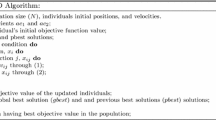Abstract
Particle swarm optimization (PSO) is a popular population based approach used to solve nonlinear and complex optimization problems. It is simple to implement and swarm based probabilistic algorithm but, it also has drawbacks like it easily falls into local optima and suffers from slow convergence in the later stages. In order to reduce the chance of stagnation, while improving the convergence speed, a new position updating phase is incorporated with PSO, namely fitness based position updating in PSO. The proposed phase is inspired from the onlooker bee phase of Artificial Bee Colony (ABC) algorithm. In the proposed position updating phase, solutions update their positions based on probability which is a function of fitness. This strategy provides more position updating chances to the better solutions in the solution search process. The proposed algorithm is named as fitness based particle swarm optimization (FPSO). To show the efficiency of FPSO, it is compared with standard PSO 2011 and ABC algorithm over 15 well known benchmark problems and three real world engineering optimization problems.



Similar content being viewed by others
References
Angeline P (1998) Evolutionary optimization versus particle swarm optimization: philosophy and performance differences. In: Androutsos D, Plataniotis KN, Venetsanopoulos AN (eds) Evolutionary programming VII. Springer, Berlin, pp 601–610
Ciuprina G, Ioan D, Munteanu I (2002) Use of intelligent-particle swarm optimization in electromagnetics. IEEE Trans Magn 38(2):1037–1040
Clerc M (2012) List based pso for real problems
Diwold K, Aderhold A, Scheidler A (2011) Performance evaluation of artificial bee colony optimization and new selection schemes. Memetic Comput 3(3):1–14
Eberhart R, Kennedy J (1995) A new optimizer using particle swarm theory. In: Proceedings of the sixth international symposium on micro machine and human science (MHS’95). IEEE, Nagoya, pp 39–43
El-Abd M (2011) Performance assessment of foraging algorithms vs. evolutionary algorithms. Inf Sci 182:243–263
Gai-yun W, Dong-xue H (2009) Particle swarm optimization based on self-adaptive acceleration factors. In: 3rd international conference on genetic and evolutionary computing 2009 (WGEC’09). IEEE, Danvers, pp 637–640
Karaboga D, Basturk B (2007) Artificial bee colony (ABC) optimization algorithm for solving constrained optimization problems. Found Fuzzy Logic Soft Comput 4529(1):789–798
Kennedy J, Eberhart (1995a) Particle swarm optimization. In: Proceedings of IEEE international conference on neural networks, vol 4. IEEE Service Center, Perth, pp 1942–1948
Kennedy J, Eberhart RC (1995b) A new optimizer using particle swarm theory. In: Proceedings of 6th symposium on micro machine and human science, Nagoya, Japan, pp 39–43
Kim JJ, Park SY, Lee JJ (2009) Experience repository based particle swarm optimization for evolutionary robotics. In: ICCAS-SICE. IEEE, Washington, pp 2540–2544
Li XD, Engelbrecht AP (2007) Particle swarm optimization: an introduction and its recent developments. In: Geneticevolutionary computation conference, pp 3391–3414
Liang JJ, Qin AK, Suganthan PN, Baskar S (2006) Comprehensive learning particle swarm optimizer for global optimization of multimodal functions. IEEE Trans Evol Comput 10(3):281–295
Mahdavi M, Fesanghary M, Damangir E (2007) An improved harmony search algorithm for solving optimization problems. Appl Math Comput 188(2):1567–1579
Mann HB, Whitney DR (1947) On a test of whether one of two random variables is stochastically larger than the other. Ann Math Stat 18(1):50–60
Onwubolu GC, Babu BV (2004) New optimization techniques in engineering, vol 141. Springer, Berlin
Ragsdell KM, Phillips DT (1976) Optimal design of a class of welded structures using geometric programming. ASME J Eng Ind 98(3):1021–1025
Rahnamayan S, Tizhoosh HR, Salama MMA (2008) Opposition-based differential evolution. IEEE Trans Evol Comput 12(1):64–79
Ratnaweera A, Halgamuge SK, Watson HC (2004) Self-organizing hierarchical particle swarm optimizer with time-varying acceleration coefficients. IEEE Trans Evol Comput 8(3):240–255
Sandgren E (1990) Nonlinear integer and discrete programming in mechanical design optimization. J Mech Des 112:223
Shi Y, Eberhart R (1998) A modified particle swarm optimizer. In: IEEE international conference on evolutionary computation proceedings. The 1998 IEEE world congress on computational intelligence. IEEE, Los Alamitos, pp 69–73
Shi Y, Eberhart Y (1998) Parameter selection in particle swarm optimization. In: Androutsos D, Plataniotis KN, Venetsanopoulos AN (eds) Evolutionary programming VII. Springer, Berlin, pp 591–600
Williamson DF, Parker RA, Kendrick JS (1989) The box plot: a simple visual method to interpret data. Ann Intern Med 110(11):916
Zhan ZH, Zhang J, Li Y, Chung HSH (2009) Adaptive particle swarm optimization. IEEE Trans Syst Man Cybern Part B 39(6):1362–1381
Zhang W, Li H, Zhang Z, Wang H (2008) The selection of acceleration factors for improving stability of particle swarm optimization. In: Fourth international conference on natural computation 2008 (ICNC’08), vol 1. IEEE, Haikou, pp 376–380
Author information
Authors and Affiliations
Corresponding author
Rights and permissions
About this article
Cite this article
Sharma, K., Chhamunya, V., Gupta, P.C. et al. Fitness based particle swarm optimization. Int J Syst Assur Eng Manag 6, 319–329 (2015). https://doi.org/10.1007/s13198-015-0372-4
Received:
Published:
Issue Date:
DOI: https://doi.org/10.1007/s13198-015-0372-4




